June 4, 2017 Leave a Comment
+1 Tweet Share Pin WhatsAppShares 0After two plus years of My Little Moppet, I am certain that I have answered a question from pretty much every area of parenting. Unsurprisingly, Moms’ favorite questions are all in the field of nutrition. While weight gain, breastfeeding and recipe requests are common, there’s one question that always makes its way to my inbox – How much should a baby eat?
The short answer to this is to feed till the baby pushes the spoon away. However, most Moms aren’t satisfied with this answer! So we have got here a detailed guide on exactly how much your baby should eat for proper growth and healthy weight gain.
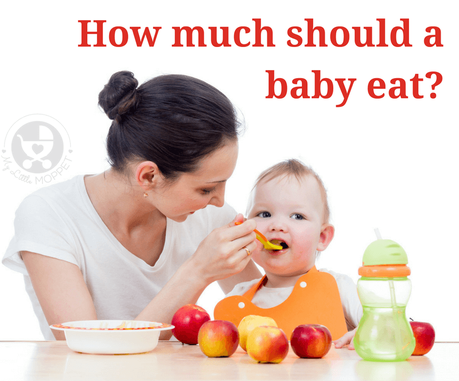
How much should a Baby Eat?
First of all, you need to ensure that you’re introducing solids at the right time and in the right way. According to WHO guidelines, it is advised to exclusively breastfeed your baby for the first six months and to introduce solids after that. Check out our earlier post on how much milk your baby should have.
Secondly, it is important to remember that every baby is different and each baby’s appetite and feeding rhythms will vary greatly. A few factors that affect the appetite of babies are:
1. Teething
Teething babies undergo a great deal of discomfort with their gums as they cut their first teeth. Their gums hurt, they drool a lot and experience a general sense of feeling unwell. As a result their appetite suffers, and they spend some days cranky and crying and refusing to feed.
2. Sickness
If your child suddenly starts to refuse to feed and it doesn’t have anything to do with teething, then it’s likely he’s suffering from an illness. Even a simple cold or blocked nose is enough to put a baby off feeding as he finds it difficult to suck. An infection in the stomach or anywhere else can also lower the appetite.
3. Natural Fussiness
Fussiness is a normal part of growing up, even for babies. As babies grow and learn more about themselves and their environment, they may show a disinterest in food. Instead of forcing them to eat during this stage, it’s important to retain a positive attitude towards meal times and try to feed them in a playful manner.
You can check out our full post on causes for loss of appetite in babies.
How do I know if my baby is eating enough?
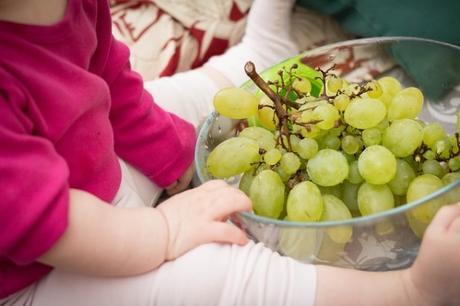
Your baby’s cues are the best indicator of whether your baby is eating enough. If she refuses the next spoon then it’s better to stop the feeding and give a different meal after 2 hours. It is important to ensure the right combination of foods so that your baby doesn’t get bored and gets complete nutrition too.
Introducing a new food can be hard, and it can take 10-15 tries over a few months before your baby will actually accept a new food. Babies can pick up on parents’ emotions, so don’t get discouraged or upset when baby refuses a new food. Staying persistent and positive is crucial for feeding success.
How much should a 6 month old baby eat?
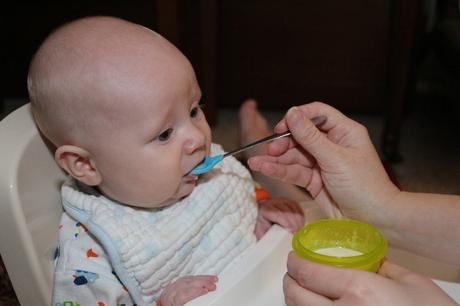
6 months of age is the best time to start solids as your baby’s body is now ready to sit upright and take in food from a spoon. Yet, since she’s just a beginner, it’s important not to get over enthusiastic and start feeding large quantities right away. Start slow with 1 tablespoon a day and gradually introduce new foods. Always remember to follow the 3-Day rule with every new food to ensure your baby has no trouble digesting it. For this age, you can follow the schedule below:
Day 1 – Start with 1 tablespoon once a day (Best choice for the first food is Apple puree (as it is sweet), make it runny by adding breast milk or formula feed)
Day 2 – Increase to 2 tablespoon of Apple puree twice a day
Day 3 – Increase to 3 tablespoon of Apple puree twice a day
Day 4 – Next solid can be a vegetable, can start with carrot, Give 1 tablespoon of either Carrot Juice or Carrot Puree once a day
Day 5 – Increase to 2 tablespoon of Carrot juice/puree twice a day
Day 6 – Increase to 3 tablespoon of Carrot juice/puree twice a day
Day 7 – Morning Apple puree, evening Carrot juice/puree
For the coming weeks, you can introduce newer foods but stick to the same quantities. You can find a detailed food chart for 6 months here. The aim is not to overwhelm baby, but at the same time get him used to a variety of foods so he gets all his nutrients. By the end of the month a baby can have 2 meals a day of approximately 30 ml each, along with breastfeeding on demand.
How much should a 7 month old baby eat?
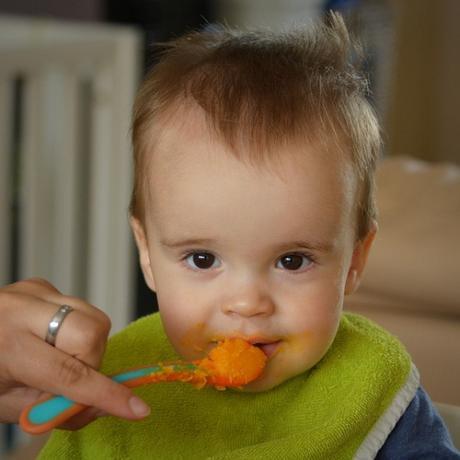
As your child turns 7 months old and has been fine with the schedule of the previous month, you can increase the number of meals to three. The timings of feedings will depend upon your baby and your family’s routine, but this is a good time to structure his meals into breakfast, lunch and dinner.
The quantity of each feed in this month will be roughly the size of your baby’s fist which is around 90 to 100 ml. Make sure his diet includes legumes, cereal, fruit and veggies, and the texture can be thicker than last month, which may affect the quantity of food in a teaspoon slightly.
Check out our full menu plan for a 7 month old baby that has been planned with gradually heavier foods being introduced through the weeks. Please remember that breastfeeding is still an important part of baby’s diet, so continue to feed on demand.
How much should an 8 – 9 month old baby eat?
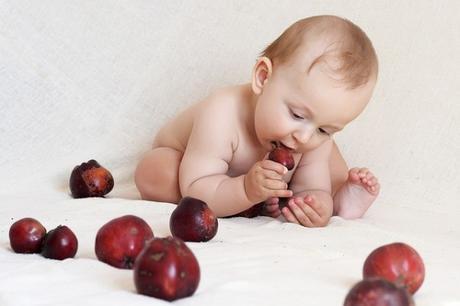
By 8 months, most babies have mastered the pincer grasp and have the coordination to take objects into their mouths without difficulty. This makes this a good time to introduce finger foods and allow them to feed themselves. In addition to the three main meals from last month, two snacks can also be introduced, preferably during mid mornings and late afternoons.
Checking how much your baby is eating starts to get trickier now. Since she’s self feeding, the foods are probably chunkier and heavier than a puree or porridge. At the same time, babies play with their food, so not everything you offer is being eaten. Follow your baby’s cues – if the amount you served at 7 months is being eaten rapidly, you might want to increase the foods served at the three meals by a tablespoon or two. Your baby will soon tell you when she’s done with it. They can probably have a small pancake or a small dosa by themselves. Include more texture in purees and porridges. You can also introduce eggs, chicken and fish at this stage.
For snacks, focus on variety rather than quantity. Start with 2-3 pieces of fruit or vegetable at the beginning. Remember that most of baby’s calories still come from breastfeeding, so don’t skimp on breast milk. Check out our 8 month food chart and 9 month food chart for more detailed meal plans.
How much should a 10-11 month old baby eat?
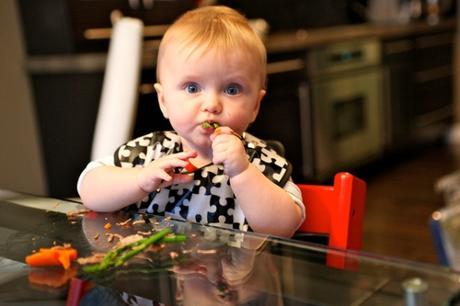
By 10 months, it’s a good idea to stop purees altogether since your baby can handle tougher foods. Now your baby’s meal can resemble an adult meal with servings of grain, vegetable and protein. Just be sure to keep them baby friendly, take care of choking hazards and avoid cow’s milk, honey, salt and sugar. This is an age when babies may start to assert themselves and turn their noses at certain foods or show a loss of appetite. Spices are a good way to rekindle their interest in food, as well as trying to make mealtime a pleasant experience, like eating with the family.
Since baby is now eating whole foods, the amount of food may appear smaller, but it’s only because it is now chunkier and heavier. Again, continue to breastfeed in between meals, probably every 5-6 hours or so. Basically, the rule ‘ offer as much as your baby will eat’ seems to work generally. The important thing from now on is to focus on offering wholesome, healthy foods and not processed or fast food. You can refer our 10 month old and 11 month old food charts for more details on the different foods your baby can eat.
Once your baby hits her first birthday, she can pretty much eat everything the family is eating. For more details on the quantity of food, please refer our post on how much a toddler should eat.
Things to Remember:
- Offer as much as your baby wants to eat
- Don’t force feed
- Don’t get upset about how much your baby is eating
- Continue to breastfeed on demand, especially till the first birthday
- Avoid salt, sugar, honey and cow’s milk before the first birthday
- Follow your baby’s cues to realize when he’s had enough
As you can see, deciding how much a baby should eat is not rocket science! Like everything else, you are the best judge of your baby’s eating habits, and you should listen to your instincts. Babies vary widely in how much they eat, and the age of starting solids also plays a small role. Don’t compare your little one to other children; your journey is all your own, so enjoy it together and to the fullest!
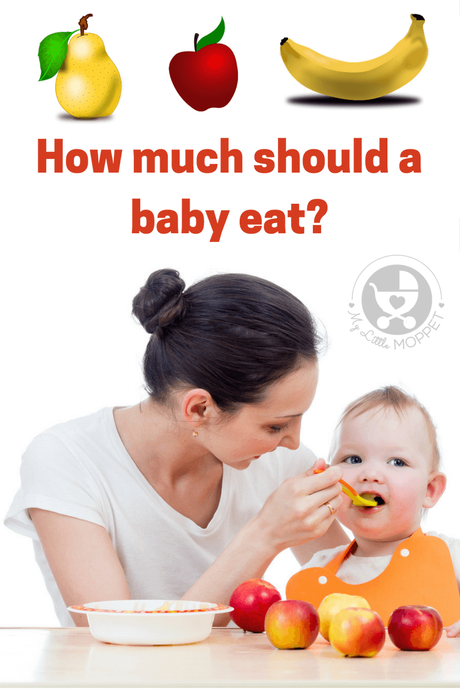
Want to see videos of our recipes ?
VISIT OUR YOUTUBE CHANNEL +1 Tweet Share Pin WhatsAppShares 0
Filed Under: Baby Food Chart, Nutrition, Starting Solids Tagged With: baby food, baby food chart, how much should a baby eat, how much should my baby eat, nutrition, starting solids, tips to start solids for baby, weaning
